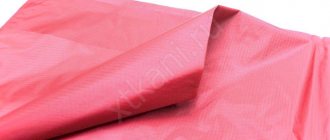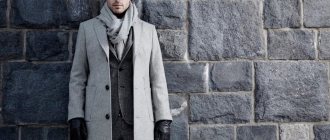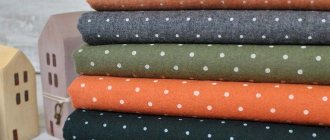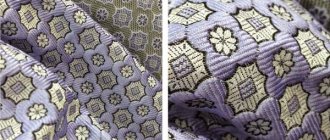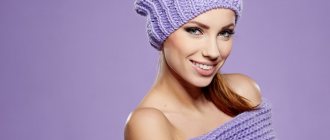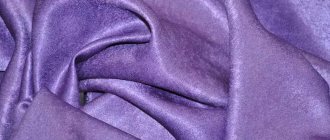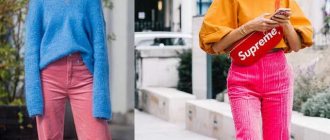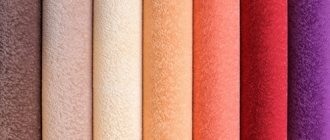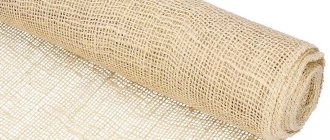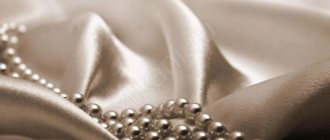In 2021, we released a new product - furniture facades with soft-touch coating. Demand began immediately; in the first 3 months we produced 167 square meters (about 40 kitchens) of such facades. This is the brightest and most significant trend. We are firmly convinced that soft-touch facades will firmly enter the range of all furniture manufacturers in the coming year and will remain for a long time.
Firstly, for those who are not familiar with the concept of soft touch, this is:
- velvety coating, pleasant to the touch;
- super matte shade, does not give glare;
- wear resistance - does not scratch, does not get dirty;
- easy to clean with any detergent;
- does not fade in the sun and does not lose color;
- 1600 colors to choose from.
Read more about SOFT-TOUCH facades
Story
The fabric with the unusual name soft replaced the usual natural materials - cotton, linen, wool, silk - at the turn of the 20th and 21st centuries. The appearance of soft material became possible after the active introduction of synthetic polyester fibers into textile production.
The material quickly gained popularity due to its exceptional softness and combination of positive characteristics, practicality and ease of use.
Scientists continue to work with the fabric and create its varieties, adding new qualities, improving the composition and expanding the scope of application.
What type of fabric is this?
Soft is a material consisting of synthetic fibers with the addition of other threads to increase strength, softness, and elasticity. The material is made of polyester.
Polyester
Popular synthetic fabric polyester: what is known about its characteristics and areas of application?
more details
The front side of the fabric is embossed with short thick pile, the back side is smooth. Both sides come in either a shiny or matte finish, depending on the fibers added.
The pile on the front side can be thick, thin, long, thinned, short and soft. Sometimes an artificially aged look is achieved by cutting the pile. The material is soft, heavy, dense, falls beautifully.
What distinguishes soft from velvet and velor is its softness, lightness and pliability in draperies.
Velvet
Luxurious velvet fabric: a detailed review
more details
Velours
Review of fleecy velor fabric: from definition and properties to the approximate price of the material
more details
The fabric is dyed in rich monochromatic colors that do not fade in the sun. The material shimmers with shine and flows easily when folded.
Software colors
The design is applied using thermal printing; as a result, the print is deeply absorbed into the fibers and remains fresh for a long time.
To protect against dust, the fabric is covered with a layer of nylon or treated with a repellent solution.
Turkey, China and South Korea are considered the main software producers in the world.
Fabric production consists of:
- Chemical processing of petroleum and hydrocarbons into polyester fibers.
- Weaving fibers into fabric.
- Napping.
- Final processing (painting, impregnation with a protective composition, drawing).
High quality fabric with any type of additives - no synthetic smell, low elasticity along the grain.
Application
Types of fabric vary in application and are suitable for sewing dissimilar products:
- clothing fabric - dresses, blouses, home clothes;
- interior fabric - bed linen, blankets, pillows, mattress covers, bedspreads;
- furniture - upholstery and covers for furniture;
- curtains - curtains, curtains, draperies, screens.
Furniture software imitates exquisite upholstery materials: velor, plush, embossed velvet. The material is distinguished by its high strength, variety of textures, and in production it undergoes a special treatment with a composition that protects against moisture, mold and deep penetration of contaminants. Furniture with soft upholstery attracts with its beauty of appearance and durability of use.
Bright kaleidoscope
The color palette of the software is varied. The material can be presented in plain light or dark panels. Curtain software is often painted in delicate, pastel shades. The furniture imitates various exquisite textures: embossed velvet, velor, plush. Printed fabrics are often chosen for tailoring.
Patterned fabric is made in 2 ways:
- Using thermal printing. This method allows you to get beautiful, clear prints. It also has an additional property - it gives the canvas moisture resistance.
- 3D drawings. The contours of a three-dimensional image are cut from a long pile. This is how texture and realism of the pattern are achieved.
Note: The ornament on the canvas does not fade for many years. It is resistant not only to detergents, but also to ultraviolet radiation. Therefore, even capricious prints applied using 3D technology retain the richness of the shades.
Description of the fabric: composition, properties, characteristics
The main distinctive quality of the material is reflected in its name: in English, “soft” means “gentle, soft.” Soft is an extremely soft material that is pleasant to the touch. In appearance it resembles velor: a fleecy front surface is combined with a smooth, even back.
Fabric strength and abrasion resistance are tested using the Martindale test. Curtain software can withstand up to 6,000 cycles, furniture software can survive 30,000 cycles, which is an excellent result.
The usual soft composition is 100% polyester.
To increase elasticity, elastane and lycra fibers are added to the fabric, to make the material more hygroscopic and breathable - viscose or cotton; if necessary, to provide the fabric with moisture- and windproof properties, nylon is included in the composition. The final composition of the fabric determines its appearance: the soft looks matte or shiny, has short dense or sparse long pile.
Curtain software is most often painted in a single color; manufacturers choose soft, pastel, discreet colors. Brightly printed material is common in clothing. The thermal printing method is used to apply patterns to the surface. A three-dimensional pattern, as if cut on a pile surface, is popular.
Recently viewed with this fabric: Velvet
An important characteristic of the material is wear resistance: the material does not deform, wrinkles little, does not fade under the bright rays of the sun, and does not fade.
Natural software fully meets all existing requirements and standards, is absolutely non-toxic, and safe to use.
Positive traits
The fabric, in demand among textile designers, has increased strength and durability.
Soft material has many other advantages:
- Softness and obedience.
- Wear resistance, thanks to which the fabric can withstand about 6000 washes.
- Color fastness – the brightness of the color is maintained even under sunlight.
- Density and dimensional stability.
- Does not fade or deform when washed.
- Excellent drape.
- Convenient to cut and sew.
- Provides reliable protection from light and noise.
- Easy care.
- The software is not susceptible to fungi, moths, or mold.
- Does not accumulate dust and odors, and dirt is easily washed off.
- Cleans well with a vacuum cleaner or a wet brush.
Kinds
There are various types of material on sale:
- soft satin - fabric with cotton or viscose threads for sewing bed linen;
- soft silk is a double-sided fabric, one side is smooth and glossy, the other has a characteristic soft short pile, suitable for sewing beautiful clothes;
- flock soft is a durable fabric used in the furniture industry;
- stretch soft - an elastic material with lycra or elastane in its composition, used to create sleep accessories;
- super-soft Niagara - a newfangled lint-free dress fabric, thin, elastic, elegant;
- soft blackout - the material is distinguished by its density and light-proof properties, necessary for the production of practical curtains.
Advantages and disadvantages of the software
Soft fabric has positive consumer qualities:
- softness;
- strength;
- long service life;
- drapeability;
- dirt-repellent properties;
- wear resistance;
- dimensional stability;
- color fastness;
- ability to resist the spread of mold and fungi;
- ease of working with fabric.
Disadvantages of Matter:
- for many, the unnatural composition matters;
- insufficient breathability;
- low hygroscopicity, with the exception of fabrics containing viscose;
- high electrification, which can be prevented by the use of antistatic agents.
Care instructions
- Soft furniture upholstery can be cleaned with a soft damp brush or treated with a washing vacuum cleaner. To remove random stains, use a soap solution.
- Curtains are cleaned of dust once a week with a dry brush.
- Washing clothes and curtains is done in water at temperatures up to 40 degrees. Dry things naturally, carefully straightening them out. Iron from the wrong side with a non-hot iron.
- To care for fabric, do not use bleaches, aggressive washing powders, or brushes with hard bristles: they easily damage the structure of the material and render the item unusable.
Products made from soft fabric, which includes viscose, are treated with delicate care: they should be washed on a gentle cycle or by hand, or entrust the care of them to professional dry cleaners.
Advantages of the software
After describing the soft fabric, it is worth talking about its positive properties.
- Soft and very pleasant texture to the body.
- Durable fabric is suitable for sewing bedspreads, upholstery, and outerwear.
- The wear resistance of the software allows you to wear things made from it for many years.
- Suitable for any draperies.
- Does not fade when exposed to sunlight.
- Doesn't shrink after washing.
- Easy to wash and no need to iron.
- Dries quickly.
- Thick enough to block out the sun's rays if you sew curtains from it.
- Clothes made from software have an attractive appearance.
- Dirt-resistant and water-repellent properties keep products made from this textile clean and tidy for a long time.
- Soft fabric is easy to process and easy to sew from. In addition, products can be cut in any direction (both horizontal and vertical).
Sofa upholstery made of soft fabric makes furniture popular due to the material being pleasant to the body
Recommendations for use
- To choose quality material, you should carefully examine the sample provided in the store. You should refuse the purchase if the fabric has lint, leaves traces of paint on your hands, or emits an unpleasant chemical odor.
- Cutting products made from software is equally successful in two directions: length and width. This trick allows you to save material and sew curtains of non-standard sizes.
- Savings are also facilitated by the fact that to create beautiful rounded draperies, double the length of the fabric is enough.
Customer Reviews
Buyers respond positively to soft curtain fabric, praising its softness and delicacy. They note that the material looks impressive and neat. A special advantage is ease of care: the material is easy to wash, dries quickly, and does not require ironing. Less popular is software for clothing; despite its beauty and lightness, the stumbling block is the polyester composition: the majority of users are wary of synthetics.
Soft is a popular fashionable fabric, a market leader among curtains and furniture materials. It looks sophisticated and stylish, helping to create an atmosphere of comfort in the interior. It is used less often in sewing outfits, but it emphasizes individuality when creating an image.
Stretches or not, real review
To finally figure out the question of “whether the software stretches or not,” I decided to go to the store and check the stretchability of the fabric with my own hands. As you can see in the photo, the fabric easily stretches and returns to its original size. The soft stretches quite easily, due to the fact that it contains elastic fibers such as lycra or nylon. It should be noted that the fabric stretches in both longitudinal and transverse directions.
See similar articles
- Modal - lightweight cellulose fabric for linen and clothing
- Chenille - thick velvety fabric for interiors
- Percale - durable fabric for luxury bedding
- Oil - dense, delicate fabric for women's clothing and dresses
- Gabardine is a breathable fabric that repels water
- Velor - soft fabric with pile, for clothing and interior
If you liked the article, share it with your friends!
Compound
The soft material always contains polyester fibers. The canvases can either consist entirely of it or be mixed.
Cotton or viscose is added to fabrics used for tailoring. Natural and artificial fibers improve breathability and the ability of the material to wick moisture away from the body.
To increase the elasticity of the fabric, elastane is added to polyester. Its percentage varies from 1% to 30%. This material stretches well both along the warp and weft. Clothes made from it do not hinder movement. Nylon is included to make the fabric fire or water resistant.
Polymer impregnations are applied to furniture fabric. They protect against accidentally spilled liquids and do not allow dirt to penetrate deeply between the fibers.
